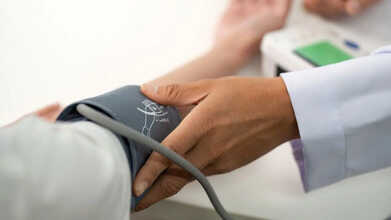- Health Conditions A-Z
- Health & Wellness
- Nutrition
- Fitness
- Health News
- Ayurveda
- Videos
- Medicine A-Z
- Parenting
Breast Cancer Awareness Month: Nutritionist Reveals 6 Foods That May Lower Breast Cancer Risk

Credits: Canva
October is Breast Cancer Awareness Month, making it the perfect time to focus on habits that can help protect your health. While no single food can guarantee prevention, research shows that certain nutrients and antioxidants found in everyday foods may play a role in reducing the risk of breast cancer. For women, especially those with risk factors, incorporating these foods into your diet can be a meaningful step toward prevention.
Understanding Breast Cancer
Breast cancer occurs when breast cells start to grow abnormally and form tumours. If these tumours are not treated, they can spread to other parts of the body and become life-threatening. According to the World Health Organization (WHO), this disease claimed an estimated 670,000 lives worldwide in 2022. In India, breast cancer is also increasing, with one in 28 women now at risk. This makes it all the more important to understand ways to lower risk through lifestyle and dietary choices.
6 Foods To Prevent Breast Cancer
Nutritionist and weight loss specialist Leema Mahajan took to her Instagram to highlight the power of food in breast cancer prevention. She emphasizes starting early: “Introducing these foods into your diet from a young age can help reduce your chances of developing this disease later in life.” Mahajan identifies six key foods backed by research for their potential protective benefits.
1. Pomegranate
Pomegranates are rich in compounds called ellagitannins, which studies suggest may help slow down the growth of cancer cells and limit estrogen-driven tumour development. Mahajan recommends enjoying one cup of fresh pomegranate each day. “Fresh pomegranate seeds can support your body’s fight against abnormal cell growth. It’s simple, delicious, and effective,” she says.
2. Cruciferous Vegetables
Vegetables like broccoli, cauliflower, cabbage, and Brussels sprouts belong to the cruciferous family, known for their cancer-fighting properties. These vegetables contain sulforaphane, a compound that aids the liver in breaking down harmful estrogen by-products and may help prevent tumour formation. Mahajan advises, “Include cruciferous vegetables in your meals three to four times a week. You can eat them raw in salads or lightly steamed to retain their nutrients.”
3. Berries
Berries such as blueberries, strawberries, and raspberries are packed with antioxidants, particularly anthocyanins, which help combat cell damage and inflammation. Adding a handful of berries to your breakfast or as a snack is a tasty and nutritious way to support your body’s natural defenses.
4. Fatty Fish
Omega-3 fatty acids found in salmon, mackerel, and sardines may have anti-inflammatory properties that reduce cancer risk. Including fatty fish two to three times a week can support overall health and may help maintain hormone balance.
5. Green Tea
Green tea contains polyphenols, which have been shown to slow cancer cell growth in laboratory studies. Drinking two to three cups daily can be a simple, comforting habit with potential protective benefits.
6. Tomatoes
Tomatoes are rich in lycopene, an antioxidant linked to lower cancer risk. Cooking tomatoes, such as in sauces or soups, makes lycopene more easily absorbed by the body.
Small Changes, Big Impact
Incorporating these foods into your daily meals isn’t just about prevention, it’s also about building a sustainable, healthful lifestyle. While diet alone cannot prevent breast cancer, combining these nutritious foods with regular exercise, adequate sleep, and routine medical screenings can strengthen overall health and reduce long-term risk.
Eating with awareness, enjoying colorful fruits and vegetables, and making consistent, balanced choices can empower women to take charge of their health, one meal at a time.
Is There A Link Between Your Kidney Health And Other Chronic Diseases? Lancet Study Says Yes

Credits: iStock
Turns out, kidney disease is not just a ‘kidney’ problem anymore, it can, in fact, affect other organs, and could even be linked to other chronic conditions, revealed a recent study.
In the US, more than 1 in 7 adults are affected by chronic kidney disease or (CKD). This means that 35.5 million Americans are affected by it, and what makes it worse is that 9 out of 10 people do not even know they have CKD, says the Centers for Disease Control and Prevention (CDC). Amid all these numbers thrown on to, something more concerning lies. A recent Lancet study shows a link between the rise in CKD and other chronic diseases. We are talking about chronic conditions like diabetes, high blood pressure, and obesity.
So, What Does The Study Say?
The researcher saw that 14 percent of adults who are over the age 20 or older, which makes 788 million Americans who had CKD in 2022. The biggest problem is not the disease itself, but the unawareness. Doctors, experts, and researchers from time and again have pointed out how kidney disease is often asymptomatic, this is why it is ignored until it becomes advanced. However, at that point the patients could already need dialysis or even an organ transplant. This gap in early diagnosis and treatment is what has made CKD the ninth leading reason of death, worldwide.
When you kidney functions naturally, it works as the powerhouse of filtration. A pair of healthy kidneys are able to filter and process more than 150 liters of fluid from the blood. These organs are also responsible for filtering out the waste and toxins through your urine. Not just that, but your kidneys also help in red blood cells production that keeps you healthy. When all of that does not happen, it can eventually impact every other organ in your body.
Like they say, everything is connected, and it surely is. For instance, somewhere around 20% of the blood that your heart pumps goes to your kidneys. If someone has diabetes and high blood pressure, it could damage the blood vessels and lead to protein in the urine and a slower filtration rate. It can then lead to other chronic infections, autoimmune disorders, and even genetic variants.
Kidney-Body Relation
If you leave your kidney disease untreated, it could lead to kidney failure. This is when you would be more in need of dialysis or a transplant. Doctors have pointed out that most people do not die of chronic kidney disease, rather it impacts their quality of life, worsening their cardiovascular conditions. It can lead to complications like a heart attack, a stroke, or a heart failure.
How Does This Happen?
People who have kidney diseases are at an increased risk for high blood pressure. Due to hurdles in the process of filtration, plaque build ups and hardens the arteries. This in return increases stress on the heart. In fact, the American Heart Association also defined the link between kidney and heart as 'cardiovascular-kidney metabolic syndrome'. This defines a health disorder that is a condition of the overlap of obesity, chronic kidney disease and cardiovascular diseases.
The bleed out of CKD is not just limited to your heart. The National Institute of Health, US points out that along with heart complications and high blood pressure, CKD could also lead to anemia, mineral and bone disorder, metabolic acidosis, malnutrition, and electrolyte imbalances in the blood.
So, What Is The Best Way To Keep Yourself Safe?
The first way is to note any symptoms and get yourself diagnosed. Look for signs like loss of appetite, unexplained nausea or vomiting. Do you feel tired often? Are you having trouble concentrating? Is there any change in how often you go pee?
Other symptoms like a change in your urine color or texture, or feeling itchy or dry, muscle cramps, unexplained weight loss or skin conditions could also signal towards kidney diseases.
However, not always does CKD show symptoms, experts suggest that to be one step ahead, it is important to undergo regular health checkups, including blood culture. General guidelines usually point towards getting a blood test done every 3 to 6 months. For someone with high blood pressure, diabetes or any other disease, the current guidelines say that those people should get regular blood and urine tests to screen for kidney disease. But what really happens is that though these tests exist, they are still used far too little. Doctors point out that many patients skip them because collecting a urine sample feels inconvenient, and overall awareness about kidney disease remains low. As a result, research shows that only about 35 percent of people with diabetes, and just 4 percent of those with high blood pressure, actually end up getting the recommended urine screening.
A ray of hope is that there are now several effective tools to slow the progression of kidney disease. Along with traditional options like ACE inhibitors, newer classes of medications including certain heart failure drugs and GLP-1 drugs. These medicines have shown to help protect kidney function. Although these newer treatments are not widely used yet, their adoption is steadily increasing.
What is important to remember is to also always consult your GP to ensure all preventative measures are followed carefully.
Does Drinking Cold Water Help With High Blood Pressure? Expert Reveals

Credits: Canva
Consuming enough water each day plays an important role in keeping the body working as it should. It helps digestion and metabolism, supports temperature control, aids waste removal, and keeps organs and tissues in good condition. Still, whenever blood pressure rises, many people look for quick fixes, and one of the most common questions is whether drinking cold water can calm the numbers.
The idea sounds straightforward, but the body reacts to cold in more layered ways. Knowing how cold water influences the heart and blood vessels can help separate fact from assumption. To understand this better, we spoke with Dr Rajeev Chowdry, Director of Internal Medicine at Yatharth Super Speciality Hospital, Sector 20, Faridabad.
Can Cold Water Help With Blood Pressure?
Cold water may bring down blood pressure for a brief period. Drinking chilled water can activate the vagus nerve in some individuals, which slows the heart rate and leads to a short-lived drop in blood pressure. The body also triggers a “diving reflex” when exposed to cold, such as splashing cold water on the face, and this can cause a similar short-term response.
Dr Rajeev explained, “Cold water may lower blood pressure for a small amount of time, but not enough to replace someone’s prescribed treatment for hypertension or to be trusted as a method to manage the condition.” He added that for certain people, cold exposure might have the opposite effect, causing blood vessels to tighten and raising blood pressure instead.
Blood Pressure: Who Is Most At Risk?
According to Dr Rajeev, some groups are more vulnerable to a rise in blood pressure, added strain on the heart, or other problems linked to sudden cold exposure:
- High Blood Pressure (Hypertension) — Cold temperatures narrow blood vessels, which can push blood pressure even higher and raise the risk of stroke or heart attack.
- Older Adults — With age, arteries become less flexible, making it harder for the body to adjust to sudden changes in temperature.
- People With Heart-related Health Issues — Cold exposure can place extra demand on the heart by raising blood pressure, changing heart rate in some cases, and reducing blood flow to the heart as blood vessels tighten. This may trigger chest pain for some individuals.
- Patients With Arrhythmias — Those with irregular heart rhythms may experience worsening symptoms, particularly with sudden contact with cold water.
- Individuals On BP-lowering Medication — Some may feel dizzy, lightheaded, or rarely faint if very cold conditions combine with medication that lowers blood pressure.
In summary, while water alone will not manage high blood pressure, staying well hydrated supports overall health and may contribute to better long-term blood pressure control. Anyone making changes to their routine should check with a healthcare professional, especially those already dealing with medical conditions or concerns about their blood pressure.
Is Your Skin Reacting to Toxic Air? Dermatologists Point to 8 Early Warning Signs

Credits: Canva
Air pollution is now recognised as a major trigger for skin problems. Dust, smoke residues, PM2.5 particles, and heavy metals settle on the skin through the day. They weaken the barrier, disturb the skin’s balance, and speed up signs of ageing. People living in crowded, high-traffic areas often notice dullness, pigmentation, breakouts, and sensitivity more than those in cleaner environments.
Two skin specialists helped us understand the early warning signs you should never overlook.
8 Signs Your Skin Is Reacting to Pollution
1. Sudden Dullness and Loss of Glow
Pollutants oxidise the skin’s natural lipids and damage its protective layer. This makes the face look tired and lifeless even when sleep and nutrition are well balanced. Many people notice a loss of glow on days spent outdoors, especially during peak pollution periods., as per Dr Geeta Grewal, Cosmetologist and Founder of 9Muses Wellness Clinic
2. More Blackheads and Clogged Pores
Dr Grewal notes that PM2.5 particles slip into pores and mix with sweat and sebum. This leads to blackheads, whiteheads, and congested skin. A rough, bumpy texture is one of the most common pollution-related concerns.
3. Frequent Breakouts
Rising pollution levels increase inflammation and oxidative stress, which disrupts the skin’s microbiome. These changes can bring tiny breakouts, fungal acne-like clusters, or painful pimples. Environmental irritants often act as hidden triggers, especially in urban areas.
4. Uneven Skin Tone and Pigmentation
Constant oxidative stress encourages the skin to produce more melanin. According to Dr Grewal, this results in dark spots, sun spots appearing sooner, and patchy pigmentation along the cheeks, nose, and forehead. Many people mistake this for sun damage alone, but pollution plays a major role.
5. Increased Sensitivity
If skincare products that once felt comfortable now sting or cause redness, pollution may be weakening your skin barrier. Warning signs include burning, itching, a warm sensation on the skin, or sudden irritation without a clear cause, as per Dr Ameesha Mahajan, Cosmetic Dermatologist and Founder, Eden Skin Clinic.
6. Early Fine Lines and Premature Ageing
Dr Mahajan explains that pollutants trigger free radical damage. This breaks down collagen and elastin, the proteins that keep skin firm and smooth. Over time, it leads to wrinkles, crow’s feet, and mild sagging around the eyes and mouth.
7. Dry, Rough, or Dehydrated Skin
Pollutants strip moisture and damage the barrier, causing tightness and flakiness even in people with oily skin. When the barrier is compromised, moisturisers stop working as well, which worsens dehydration.
8. Frequent Rashes or Dermatitis Flares
People with sensitive skin conditions such as eczema, psoriasis, or rosacea may notice more flare-ups when pollution rises. Dr Mahajan says that constant exposure can lead to rashes, bumps, and patchy irritation that keeps returning.
Avoiding pollution entirely is difficult, but protecting your skin is possible. Strengthen the barrier with antioxidants, sunscreen, gentle cleansers, and weekly detox habits. Watch for the early warning signs mentioned by the experts and act early. A strong skin barrier remains the most reliable way to maintain clear, healthy, and youthful skin despite rising pollution levels.
© 2024 Bennett, Coleman & Company Limited

